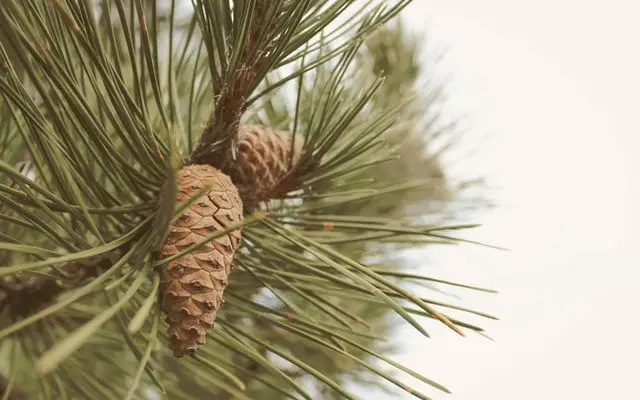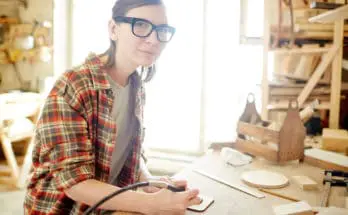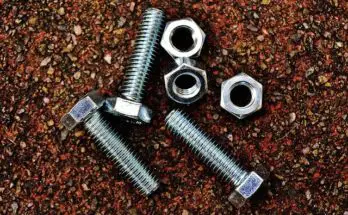As it is one of the most affordable types of wood, many beginners in woodworking may gravitate towards pine when starting their first projects. Pine seems to fit the bill for many people who are starting out in making wood furniture. It is cheap, readily available, and very easy to work with. Pine also has advantages in other areas as well.
However, pine also has its disadvantages which make it less than ideal for many applications. Because of this, the beginner needs to understand the pros and cons of pine and decide on whether it is the best material for their project.
The Basics of Pine
Pine wood comes from pine trees, with the predominant types being the Eastern White Pine and Yellow Pine. Pine trees are a type of conifer (an evergreen tree) which grow all over the world, to include North America, most of Europe, Russia, and parts of East Asia. Conifers have needle-like leaves which stay on the tree year-round and reproduce using pine cones.
These trees thrive in cooler and higher altitude environments, such as northern latitudes as well as mountain ranges. Pine is just one type of conifer; other conifers include redwoods, firs, cedar, and spruce trees.
Pine is a softwood tree by definition – the difference between softwoods and hardwoods is based off the type of tree, with conifers being labeled softwoods, and deciduous trees being labelled hardwoods. That being said, pine wood is especially known for its softness.
Pine is one of the cheapest varieties of wood, as the pine tree grows very quickly and can be regrown to fill the demand for more wood. Because pine is very soft, it is easy to work with. However, it is also quite stiff and can handle shocks relatively well.
Advantages to using Pine
There are several advantages which make pine a great material for making furniture. Perhaps most simply, pine is a very affordable type of wood, which makes it especially ideal for those who are beginners in making their own furniture. For comparison, a very expensive wood like ebony can cost upwards of 30 times more.
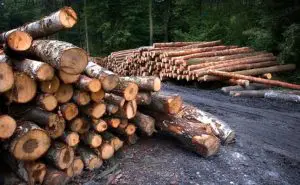 Pine is lightweight, which makes pine furniture relatively easy to carry and move around. This can be especially advantageous for homes with frail or elderly people who would struggle more with moving heavier furniture. Its material properties are also ideal for certain uses, as it is a stiff and relatively shock resistant wood, which is also soft enough to easily work with.
Pine is lightweight, which makes pine furniture relatively easy to carry and move around. This can be especially advantageous for homes with frail or elderly people who would struggle more with moving heavier furniture. Its material properties are also ideal for certain uses, as it is a stiff and relatively shock resistant wood, which is also soft enough to easily work with.
In addition, as a light-colored wood, pine is quite easy to stain and thus can be adapted to a variety of colors. People who want to add their own colorful flair to furniture may find pine to be the perfect wood to use. Another aesthetic advantage to pine is its “rustic” pattern of contrast between a largely light background combined with very dark knots.
Finally, because of pine’s fast growth cycle, it is a relatively sustainable wood to use. Environmentally conscious people who are worried about the effects of their wood use may find comfort in knowing that pine trees can be easily regrown within 30 years.
Disadvantages to Pine
Despite the advantages to using pine, there are several downsides to using pine. Although it is stiff and shock resistant, pine is still a soft wood, which makes it susceptible to scratching, denting, and other signs of wear. Although this may be okay in children’s furniture or other similar uses, it may not be the best material to use for more conspicuous spaces, like dining rooms or living rooms.
And although it has a great “country” look which might appeal to certain people, this style may also limit what type of interior spaces it will fit well in. There might be certain interior design concepts which would not work well with pine furniture.
Furthermore, in addition to its proneness to scratching and denting, pine also has other practical issues. Although the knotting seen in pine trees can be visually appealing, too much knotting can also create areas of structural weakness. An ill-placed knot can cause issues with furniture which undergoes enough stresses and strain. Finally, although many types of wood do not do well in the elements, pine is especially prone to damage when exposed to conditions such as rain and humidity.
Pine and Exposure to the Elements
Is it okay to use pine in an outdoor environment, where wind and rain are a part of the environment? The answer is that it depends. If the wood is left untreated, then pine is not a good candidate for outdoor use. Untreated pine will not hold up to the elements as well as other types of wood and will not withstand the test of time.
Issues like warping, bending, and even rotting can spell doom for untreated pine furniture exposed to rain and humidity. If untreated wood is used outdoors, cedar or cyprus would be better choices.
However, like any other wood, pine can be strengthened against the elements by properly finishing it with products such as polyurethane finish, epoxy, and paint. Even then, it would best be used in ways which do not expose it to excessive stresses. This could include using the pine as fencing, rather than as furniture. Pine is not the number one choice for outdoor use but may be acceptable if properly treated.
When to Use Pine?
Considering the advantages and disadvantages to using pine, when is it best to use the wood? There are a few areas to consider. When building furniture meant for the outdoors, it may be a better 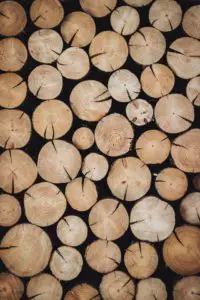 idea to steer away from pine and towards a more durable wood, while the indoors may be more appropriate for pine.
idea to steer away from pine and towards a more durable wood, while the indoors may be more appropriate for pine.
If the furniture needs to be very sturdy and durable, such as with a bed or large dresser, then using a stronger wood may be better. If the project is not as “serious” and is smaller in scale, pine can be a great starting place. If budget is an issue, pine can also be a great material to use. If you are looking to create a “heirloom” piece of furniture that can be passed down for generations, pine is not the best choice for your project.
If a big emphasize of the project is to learn how to stain wood, to experiment with different types of stain, or to showcase colored wood in the house, then pine is ideal. For people who are trying to whittle or carve wood, pine is a great option as well, because of its characteristic softness. Simply put, pine is ideal for certain scenarios, and not worth using in others. For cases where pine is not the best option, several affordable alternatives exist.
Is Pine Furniture Toxic
Believe it or not, softwoods do release a small amount of toxins into the air. Does that mean that pine is toxic and should not be used to make furniture or other items that go in your house – absolutely not. The amount of “toxins” that are released from softwoods is extremely minimal. If pine wood was toxic, it would not be sold in abundance in all the big box stores.
I have never heard of anyone getting sick due to having pine in their home. Long term exposure to sawdust can cause cancers but this is tied to woodworkers who do not protect themselves from the microscopic saw dust from their shop.
Alternatives to Pine
There are various alternatives to using pine, depending on what specific characteristics someone is looking after. For those who want to use a softwood, but want something more robust, Douglas Fir is a great option. For weather resistant softwoods, cedar or cyprus is a great alternative to pine.
People who like the environmentally friendly nature of pine but want an alternative may find that in bamboo, which is also known for its sustainability. For people who are okay with the extra cost, various types of hardwoods can be used to make furniture. Good “entry point” hardwoods which are affordable include oak or beech. That being said, beginners should avoid using the most high-end woods until they gain more experience in woodworking.
Closing
For people who first start exploring the world of woodworking, it may be difficult to figure out where to start. Even something as simple as choosing what wood to use may seem daunting. It may be tempting to simply jump to buying and using pine, since it is so cheap and is readily available at many stores. In many ways, this is actually a great place to start. Pine is soft and easy to work with, is easy to stain, and can be used to complete relatively quick furniture projects.
However, pine may not be the best option for outdoor furniture, for furniture that needs to be sturdier or stronger, or any furniture which is used in a high-profile setting, like a formal dining room. In these cases, it may be a good idea to look at other options.

